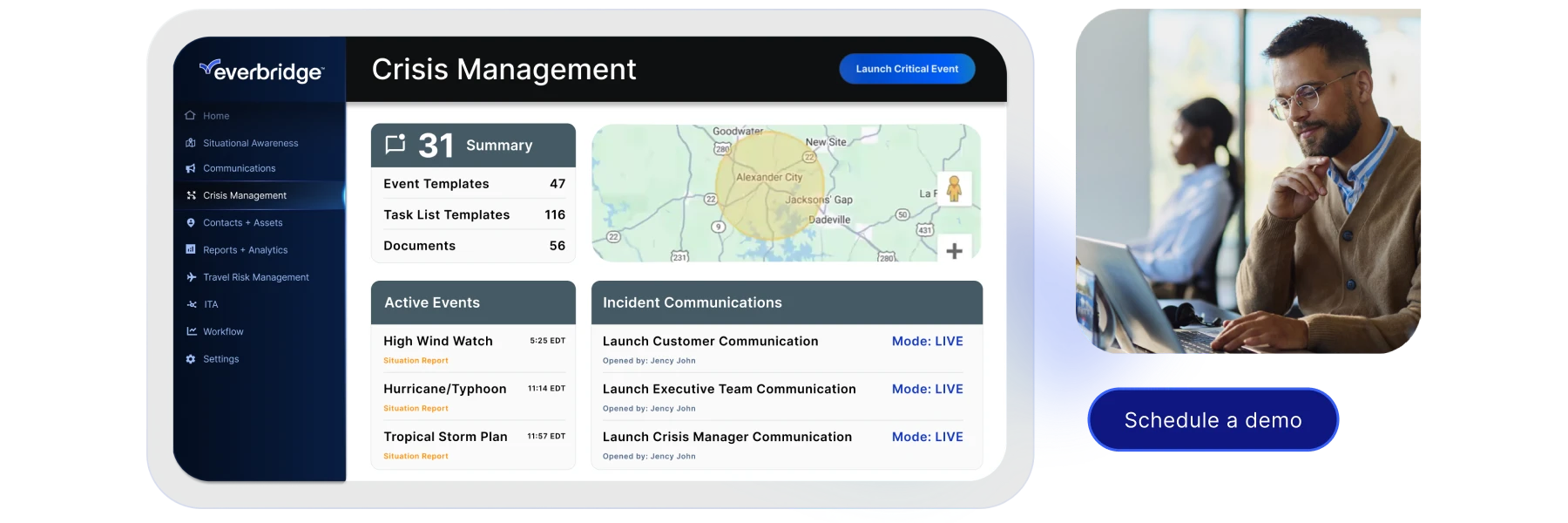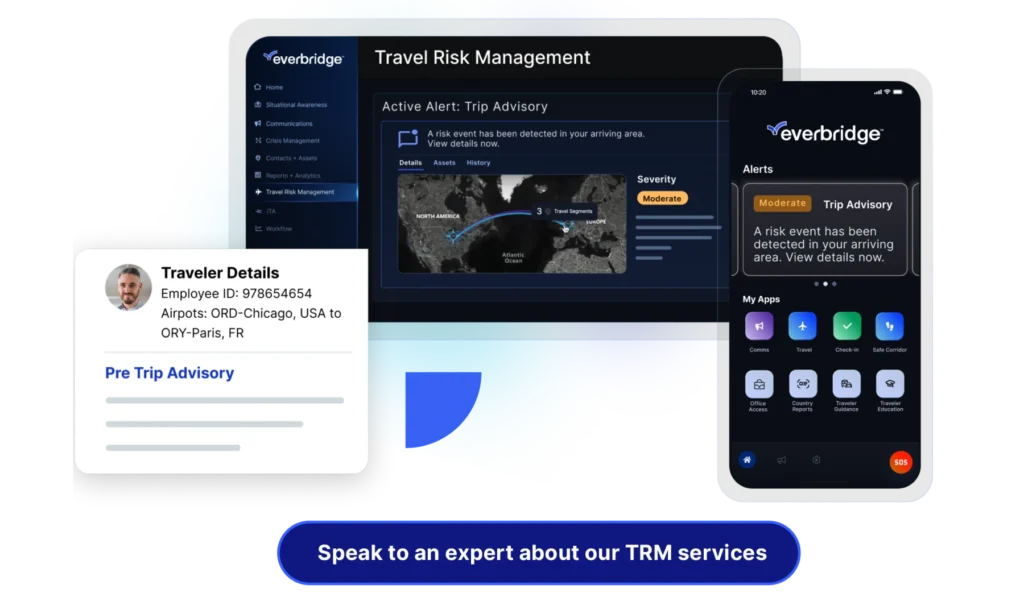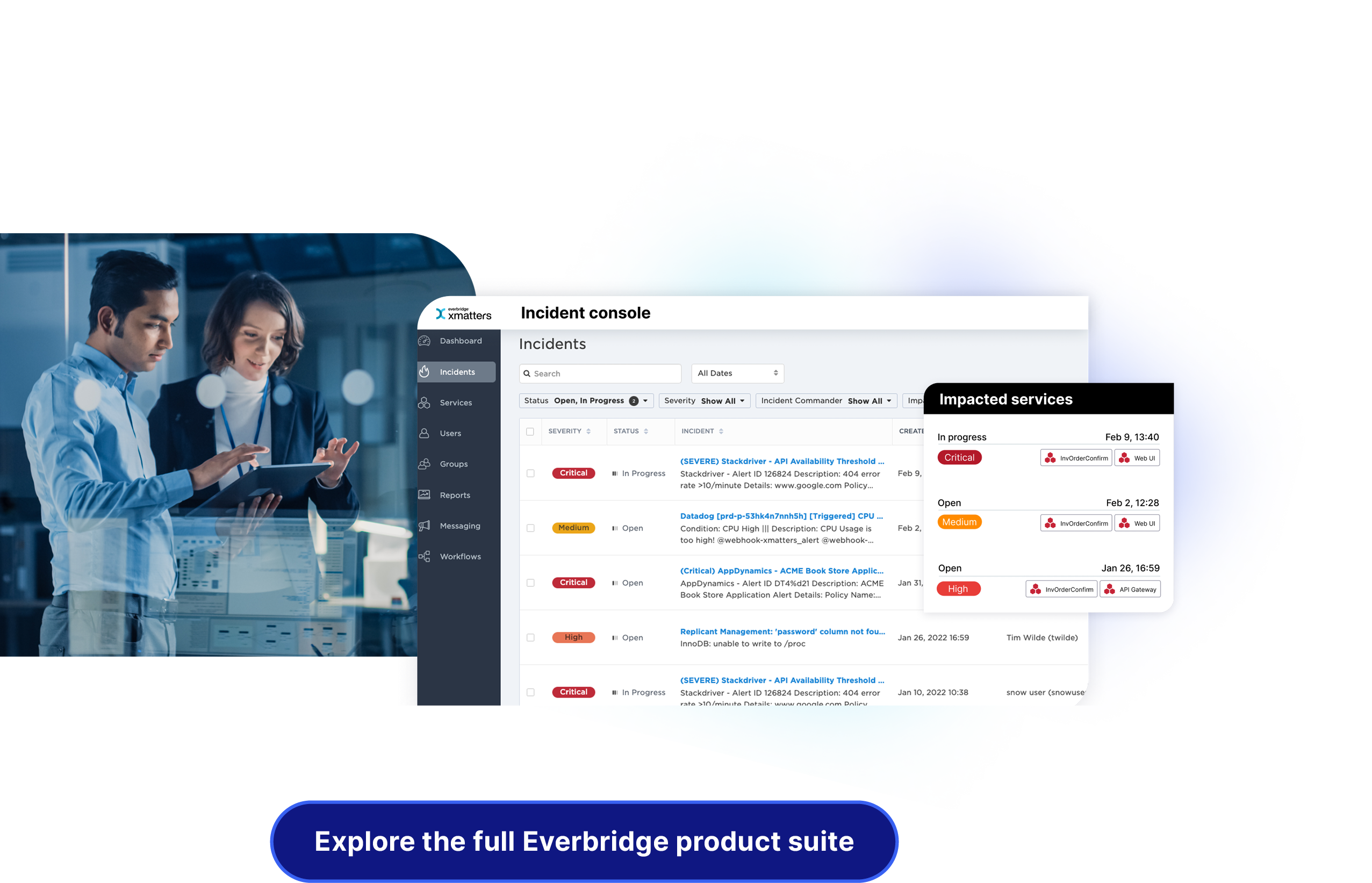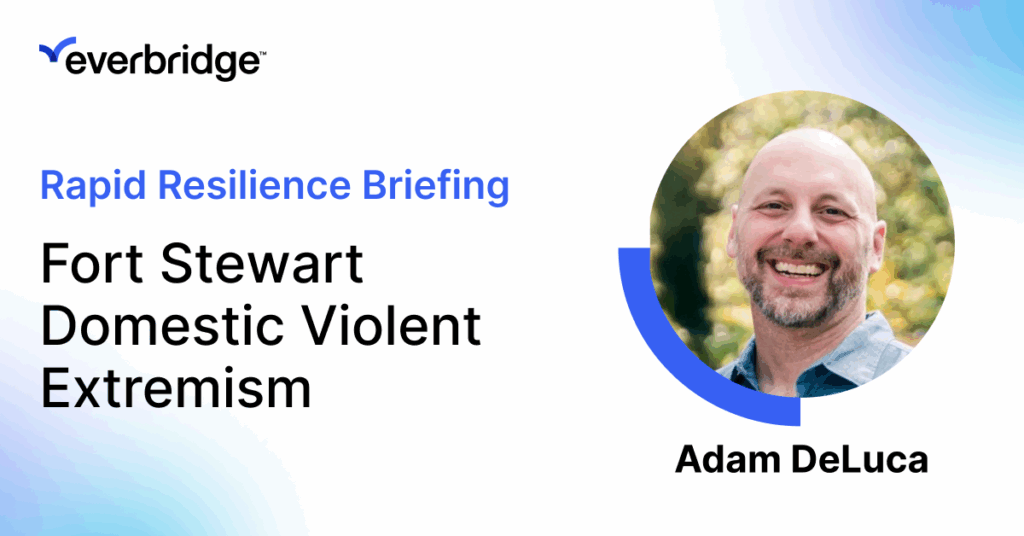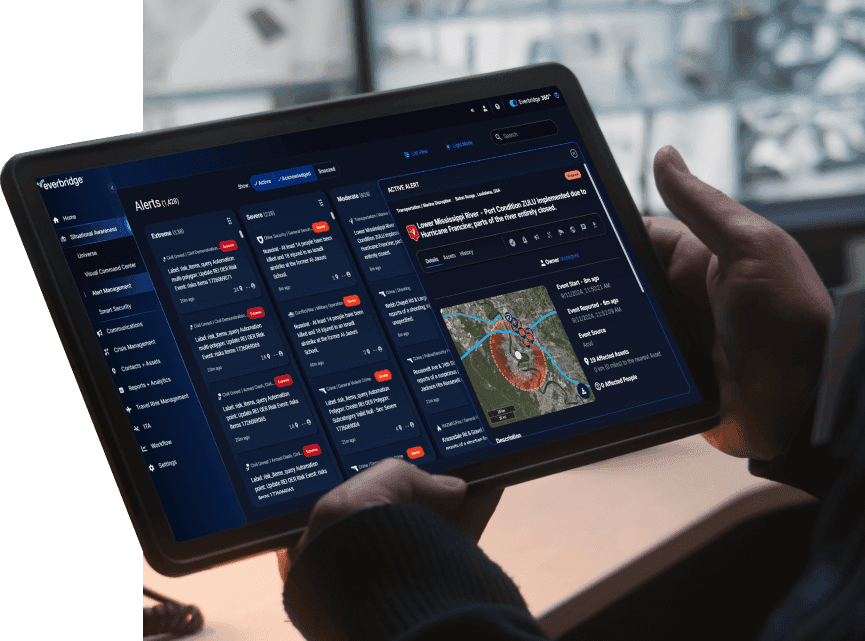
Everbridge 360 integrates advanced communication, real-time risk intelligence, and incident management into one powerful platform. This unified solution streamlines how organizations manage critical events, offering comprehensive oversight. Its two-way mass notification ensures seamless emergency communication with instant updates, real-time feedback, and critical information sharing. This capability is crucial for keeping people safe and operations running smoothly when it matters most. By uniting these powerful tools, organizations can enhance emergency response, minimize communication delays, and ultimately boost both operational efficiency and organizational resilience in the face of any threat.

“Everbridge CEM has transformed how we manage critical events, enabling us to respond faster, ensure our employees’ safety, and maintain seamless operations no matter the challenge.”
– Akamai

Everbridge BC in the Cloud unites planning, risk management, and response, to strengthen business continuity and disaster recovery while providing flexibility within a low-code platform. With built-in templates and compliance-ready workflows, it streamlines planning, automates processes, maps dependencies, and delivers real-time insights for precise incident response.
Purpose-built for resilience, it empowers organizations to strengthen business continuity and disaster recovery programs, ensuring precise responses across the entire incident lifecycle. From risk assessments to recovery, BC in the Cloud integrates planning, automation, and real-time insights into a streamlined experience.

“BC in the Cloud helps solve the lack of clarity in how organizational processes are defined and their resiliency posture. It helps consolidate and present organizational data through a resiliency lens, driving positive change through data.”
– Thomas B. Senior Business Resilience Manager

Everbridge Travel Protector™ ensures the safety and well-being of employees wherever they travel by providing 360° threat awareness, dynamic travel intelligence, and advanced communication. Travel Protector enables businesses to identify risks, issue pre-trip advisories, and monitor travel plans for VIPs or individuals heading to high-risk destinations. By delivering real-time insights and alerts, it helps organizations proactively address potential dangers, ensuring employees are informed, protected, and supported, no matter where their work takes them. Combined with Everbridge Assist, the Everbridge 24/7 medical & security assistance service, organizations can build comprehensive travel risk management programs that fulfill duty of care requirements, and comply with ISO 31030.

“At Burns & McDonnell, safety is first. With more than 13,500 employees working from 70 offices globally, we are committed to creating safe environments in the office, in the field and while traveling. Everbridge Travel Protector helps keep our teams safe wherever they go.”
– Robert Hope, Director, Burns & McDonnell
Everbridge xMatters empowers DevOps, SREs, and operations teams with automated workflows to ensure reliable infrastructure and application uptime. By streamlining incident management and enabling efficient collaboration, xMatters reduces risks and helps teams resolve issues quickly. With signal intelligence, adaptive incident management, and actionable analytics, it ensures seamless customer experiences and improved operational performance. xMatters also automates workflows to proactively manage issues associated with new releases, reducing the risk of incidents that could impact customers. Its connected, collaborative workflows provide every team with the tools they need to maintain reliability, minimize downtime, and deliver consistent, high-quality service.

“xMatters is the first step to operating globally. It’s the first thing you need to be able to manage your rotation, manage your paging, and manage your teams and operations.”
– Ben Narramore Director of Global Operations, Sony Interactive Entertainment obert Hope, Director, Burns & McDonnell

Everbridge Control Center integrates safety and physical security systems into a unified platform, providing real-time situational awareness and operational control. It offers automated workflows, enabling the streamlining of processes, accelerating response times, and ensuring consistency in managing incidents. It provides a common operating picture and delivers a cost-advantage by integrating disparate systems like CCTV, access control, and alarm monitoring, into a single-pane-of-glass for global security operations to protect both people and facilities.
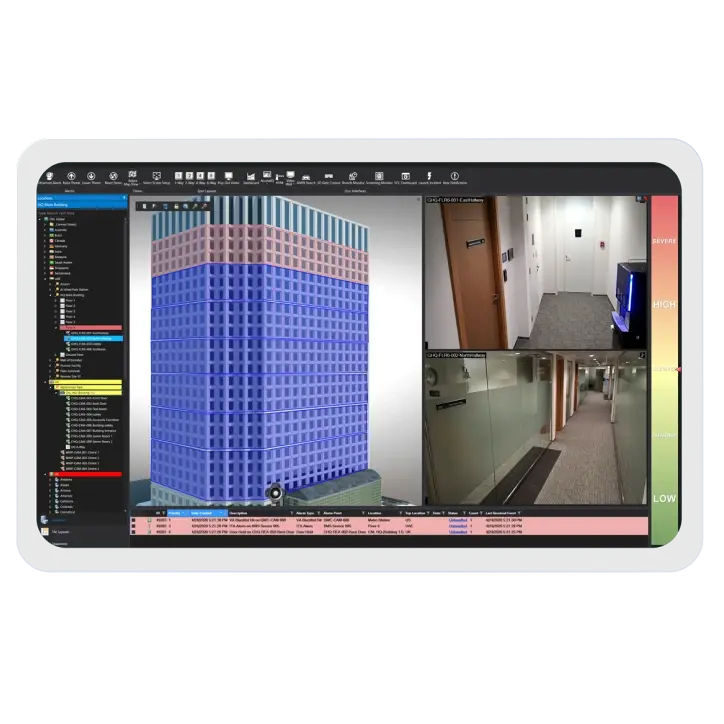

Everbridge SnapComms is a multi-channel internal communication platform designed to inform and engage with employees to help achieve 100% message readership. With unique formats like desktop takeover, tickers, and a large library of designer templates, it boosts employee engagement, delivers urgent notifications, and drives action for leadership updates.
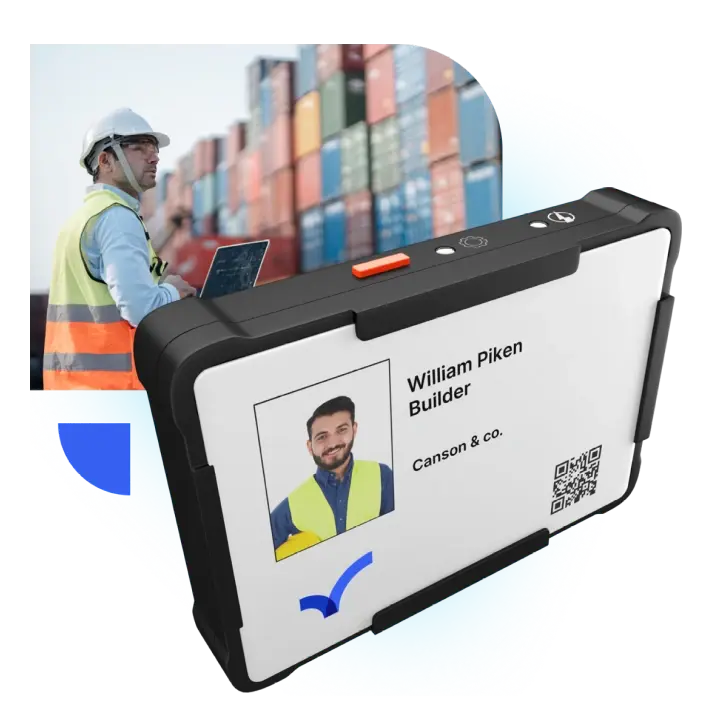

The Personal Safety Device (PSD) enhances on-the-go safety for lone workers or those in higher risk work environments. This compact, wearable device offers rapid response, peace of mind, and real-time protection through alerts, location monitoring, and reliable communication when it’s needed most.

Everbridge RedSky provides dynamic, cloud-based E911 solutions to protect mobile workforces and ensure compliance with federal regulations like Kari’s Law and the Ray Baum Act. RedSky solutions ensure that 911 calls get routed to the correct local Public Safety Answering Point (PSAP) during an emergency to protect employees wherever they are.

Signal is an AI-powered intelligence platform that tracks global sources, from social media to the dark web. It delivers real-time insights and early warnings to enhance resilience, protect people, ensure security, and safeguard organizational reputation.
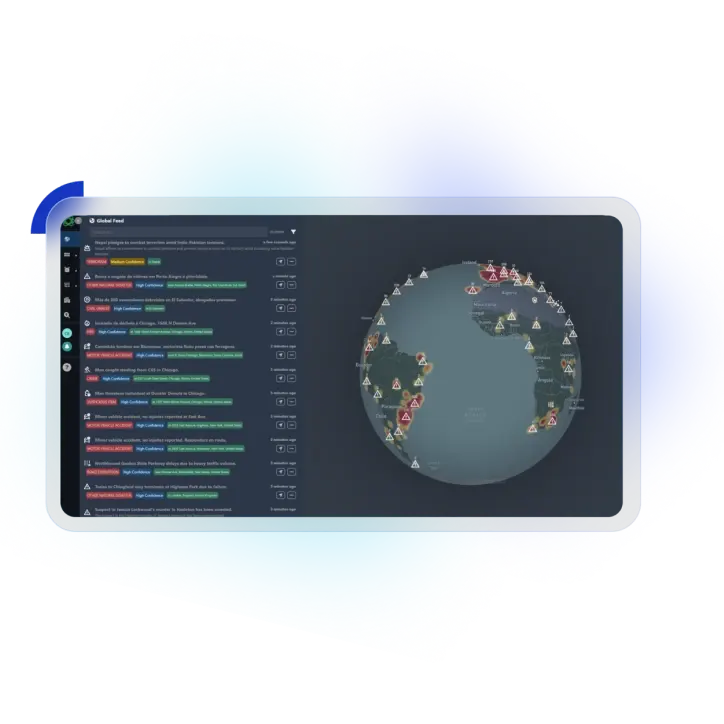
The Everbridge advantage
Everbridge offers the most comprehensive, end-to-end suite of solutions for managing both physical and digital critical events. Powered by Purpose-built AI, our High Velocity CEM™ platform delivers industry-leading actionable risk intelligence to help keep your people safe and organizations running.
The results are clear: Forrester Consulting estimates a 358% ROI for Everbridge customers over three years, including $2 million saved in IT downtime and $3 million gained in operational efficiency. With instant multi-channel notifications and full lifecycle automation, Everbridge streamlines responses, eliminates delays, and strengthens organizational resilience – all within a seamless, user friendly platform.
A unified platform for greater resiliency in critical event management
Leveraging cutting-edge technology, strategic innovation, and proven reliability, Everbridge empowers you to navigate an ever-changing risk landscape with confidence.

Today’s leaders are more exposed than ever before, due to constant digital connectivity and public visibility. This new era brings complex risks that go far beyond traditional physical security. Successful executive protection now requires a strategy that addresses both digital and physical threats, often occurring at the same time.
Recent high-profile incidents highlight the rising challenges. Organizations have a duty of care to protect their leaders, but is your executive protection program keeping pace with increasing risks? A new study undertaken by ASIS International and Everbridge uncovers critical gaps and opportunities, and this post explores how the threat landscape is evolving, what challenges organizations face, and the key strategies to build a robust protection program.
Executive protection in a shifting threat environment
Executive protection has surged up the agenda. According to the new study, 42% of security professionals report a significant increase in focus on executive protection in just the past 18 months, a clear response to a rapidly growing and evolving threat landscape.
Two major drivers are fueling this urgency:
- Rising public threats (72%): Social media and online forums amplify dissent and anger, often breeding direct threats against executives.
- High-profile incidents (69%): Events such as the assassination of a prominent CEO in 2024 have put executive risk on center stage for boards and security leaders.
The lesson is clear: executive visibility, including digital presence and company communications, increases vulnerability. Threats are now global, persistent, and often initiated online.
The modern threat: where digital meets physical
Threats today arise from the intersection of online and offline worlds, creating complex scenarios that traditional security alone cannot address.
Physical threats enhanced by technology
Traditional kidnapping and assault scenarios have evolved. Attackers use digital tools to plan incidents, analyze public routines, and bypass conventional security. Publicly shared information makes executives’ movements predictable, while personal tech can compromise safety almost anywhere.
Escalating cybersecurity threats
Cyberattacks against executives are more frequent and sophisticated. Deepfake technology, for example, can create fake video calls and social media content nearly indistinguishable from reality. One organization lost $25.6 million in 2024 when a finance employee joined a deepfake video call with “colleagues.” Online intimidation and digital surveillance are now common precursors to real-world attacks.
Challenges holding back executive protection
As risks mount, many organizations struggle to implement effective protection programs. The recent ASIS and Everbridge research spotlights disconnections between awareness, funding, and action.
Budget and executive buy-in
Budget limitations (58%) are the largest barrier, followed by executive non-compliance (47%). These challenges reinforce one another: without executive support, security programs lack funding; without resources, their value remains unproven. For programs to succeed, security must be framed as a business enabler, key to continuity, reputation, and leadership confidence, not as a mere checkbox.
Gaps between awareness and action
According to the ASIS and Everbridge research, there are stark differences between how important security professionals rate various practices and their ability to implement them:
- Online threat monitoring: 65% say it’s critical; only 51% feel equipped to do it well.
- Protecting digital assets & secure communications: 57% rate it highly; just 42% feel capable.
- Behavioral threat profiling: 48% see it as important; only 33% have solid capabilities.
These gaps reveal that while digital risks are widely recognized, many organizations aren’t yet equipped to manage them effectively.
Key strategies for modern executive protection
To address these challenges, organizations must modernize their approaches, merging analysis, technology, and people.
Integration of digital and physical security
Threats originating online can escalate rapidly into the physical world. Effective executive protection uses open-source intelligence (OSINT) and social media monitoring not just to track sentiment, but to identify specific, actionable threats. The study found that while OSINT is widely used (82%), most organizations lack the tools for real-time analysis or behavioral threat detection. Investing in these technologies makes it possible to move from reactive to proactive risk management.
Proactive travel risk management
Executive travel is still a top exposure. Yet many companies take a piecemeal approach:
- 18% rarely or never assess travel risks in advance.
- 25% don’t offer pre-travel safety briefings.
- 30% only monitor intelligence after a known threat arises.
This reactive stance leaves executives vulnerable. Best practices demand pre-trip risk assessments for every journey, thorough briefings, and ongoing monitoring, not just after a threat emerges.
Governance and training
High-level support is essential. Board oversight, adequate resources, and executive participation in security planning are crucial, not just for physical threats but as part of broader cybersecurity compliance. New SEC rules underline the need for C-suite involvement.
Yet training often lags. While situational awareness training is common, scenario-based exercises are rare, despite being invaluable for testing protocols. Fewer than half of organizations offer executives training in emergency procedures, IT security, or even self-defense, leaving many leaders unprepared for new-age threats.
Building a culture of security
Technology is only half the battle. Fostering a culture where leaders understand risks, model best practices, and cooperate with security staff is vital. Security teams should track incidents and measure the effectiveness of their programs, using data to make the business case for ongoing investment.
The path forward: resilient, data-driven protection
To secure buy-in and resources, security leaders must present protection as a strategic investment and support this with measurable results. Yet, according to the ASIS and Everbridge study, more than a third of organizations lack any formal evaluation process for executive protection.
By implementing clear KPIs, tracking incidents, and analyzing outcomes, organizations can demonstrate value, adjust tactics, and ensure constant improvement.
As the threat landscape grows more complex, protecting today’s high-profile leaders demands an integrated, data-driven approach. Digital and physical security must operate in tandem, powered by proactive intelligence, solid processes, board support, and comprehensive training.
Is your protection program evolving with the times? To benchmark your organization or learn how to strengthen executive protection, download the full Executive Threat Environment Report.
Want deeper insights and practical advice? Watch our on-demand webinar, Executive Protection in a Volatile World, and gain strategies directly from leading experts.
Understanding the nature of modern threats isn’t just important, it’s essential. With terrorism and active shooter incidents on the rise, preparation and informed decision-making are critical to ensuring safety and resilience. Leaders across organizations, public spaces, and communities need reliable insights and strategies to identify risks, plan effectively, and mitigate potential harm.
Building preparedness is about action. Trusted, up-to-date data, paired with practical checklists and clear guidance, empowers you to tackle today’s challenges with confidence.
The alarming numbers you need to know
Data tells a powerful story about the growing complexity of global risks. From terrorism to active shooter events, the statistics paint a sobering picture that no organization can afford to ignore:
Active shooter incidents skyrocket
The United States experienced a 70% increase in active shooter incidents between 2020 and 2024 compared to the previous five years. Even with a 50% drop in incidents reported in 2024 versus 2023, the underlying trends highlight the persistent threat that looms over workplaces, schools, and public spaces.
Regions in crisis
Sub-Saharan Africa continues to experience devastating impacts from terrorism, with significant fatalities among civilian populations in 2024. This region’s turbulent environment underscores the urgent need for global organizations to adapt security strategies for emerging regional risks.
These numbers aren’t just statistics—they’re urgent calls to action. Understanding the trends behind these troubling figures is the first step toward resilience.
Download our white paper, ‘Understanding the threat landscape: Trends in terrorism and active shooter incidents,’ to learn more.
Insights and strategies to build resilience
Today’s environment demands a thorough analysis of how threats have evolved. Digital platforms are transforming the landscape, enabling new methods of planning, recruitment, and hybrid attacks that blend physical and digital aggression. Awareness of these trends is indispensable for leaders who want to stay ahead of the curve.
Preparedness relies on a proactive, practical approach. Actionable checklists help evaluate and improve current measures—whether updating emergency plans, conducting regular training, or integrating new technologies to enhance crisis response. Tailored recommendations ensure organizations of all sizes can safeguard people, assets, and reputation in an increasingly unpredictable world.
Communication and coordination are critical. Leveraging technology to strengthen your response systems reduces risk and shortens crisis response time, ultimately supporting stronger outcomes.
Don’t wait for the next incident
Preparedness is a mindset, and resilience is built through decisive action. The risks are clear, but this doesn’t mean you’re powerless. Equip yourself—and your team—with the knowledge and resources that can make a real difference.
Your safety starts here. Don’t leave it to chance.
Adam DeLuca discusses the Fort Stewart incident, insider threat programs, and strategies to detect, prevent, and respond to risks.
